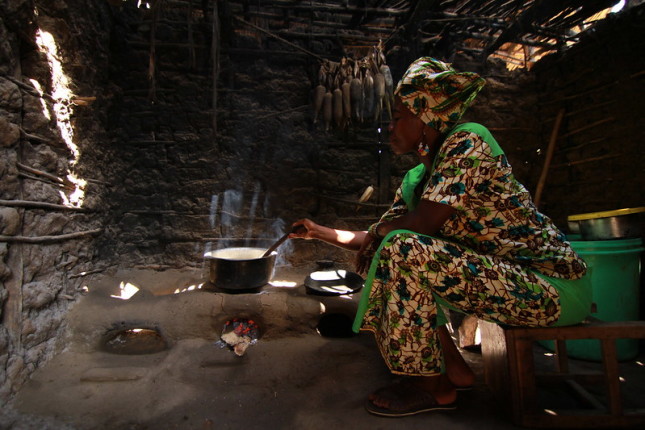-
The Climate Solutions That Play Double-Duty

Finance for climate action is growing—however, much of this money is being invested in wealthier nations, while the regions where funds are needed most are often overlooked and underfunded by both public and private institutions. The good news for funders is that there are climate solutions that not only significantly reduce greenhouse gas emissions, but also create cascading social and public health benefits for communities on the frontlines of the climate crisis. For those looking to get the biggest return on their investment—for both people and planet—we offer two particularly promising solutions: ramp up funding for clean cooking and electricity where they matter most.
Cooking up a healthier future
Globally, 2.6 billion people rely on wood, charcoal, crop residues, and manure to fuel stoves to cook food and heat their homes. Together, these fuels are responsible for almost 2.3 percent of global carbon dioxide emissions—comparable to the global aviation industry. They also emit black carbon, a by-product of inefficient burning with a warming potential second only to carbon dioxide. Clean cooking (household stoves that have a reduced climate impact due to increased efficiency, reduced emissions, and increased ventilation) hold tremendous potential for stemming the flow of greenhouse gases into the atmosphere—up to 1 billion tons of CO2 emissions every year between now and 2050.
But there is a deeper human story here: In addition to directly reducing atmospheric CO2, providing everyone with clean cooking offers abundant health, social, and environmental benefits. Household air pollution related illnesses, caused by open fires and inefficient burning, contributes to nearly four million premature deaths globally every year. The use of solid fuel for burning also disproportionately impacts the lives of women and girls, as the time it takes to fetch wood and coal results in missed educational and economic opportunities. Wood logging for cooking—especially in sub-Saharan Africa and Southeast Asia—also contributes to forest and biodiversity loss that further exacerbates climate change.
It’s true that the value of clean cookstoves has been questioned in the past due to adoption challenges, like unaffordability and lack of project oversight. Such difficulties can be overcome by devoting sufficient resources to education and aligning with local cultural values. The associated cost and challenges are not insignificant: Providing everyone with clean cooking technology by 2030 requires an investment of several billion dollars per year—orders of magnitude higher than what’s currently available. Luckily, new impact funds are stepping up to fill this finance gap, but more capital is needed. Increased funding will help alleviate issues of affordability and usage by boosting innovation and customer research, so that clean cookstoves are accessible and fully utilized. The potential rewards—avoided premature deaths, improved lives for women and girls, enhanced food security, and significant cuts to global emissions—could make this one of the biggest untapped levers for climate funders.
Shedding light—and hope
While access to electricity has increased rapidly in the last decade, more than 750 million people, mostly in sub-Saharan Africa, live without electricity, making it difficult for people to pursue an education, earn a living, obtain health care, and reap the benefits of communications technology. While investments in renewable energy generation receive the majority of climate financing and have grown tremendously in emerging economies, similar investments in sub-Saharan Africa remain abysmally low.
There is a major window of opportunity for sub-Saharan African countries to leapfrog ahead and provide much-needed electricity through clean sources of energy. With proper access to financing, the region could meet more than two-thirds of its electricity needs from renewable sources by 2050, while also generating 2 million green jobs.
Increasing the flow of clean energy funding to the often-overlooked region would be a major win-win both for funders focused on climate change and on global inequality. Clean electricity solutions, including distributed solar photovoltaics and microgrids, have tremendous cascading benefits beyond mitigating emissions. They can be transformative in improving economic opportunities, health, and food security; conserving the environment; and boosting gender and social equity—all while bolstering resilience for those worst impacted and least responsible for the climate crisis.
Expanding the portfolio of climate action
Time is of the essence: The most recent report from the Intergovernmental Panel on Climate Change (IPCC) notes there is a “rapidly narrowing window of opportunity to enable climate resilient development.” And with a reinvigorated financing pledge adopted at the recent COP26, it is not only critical to deploy additional funds quickly, but to also ensure they are funneled toward the solutions that play double-duty. By expanding the funding portfolio for climate action to seek out and include overlooked and underfunded solutions, the world can reach its climate targets while delivering on climate justice and boosting equity around clean cooking, clean energy, and more.
We have until the end of this decade to mobilize climate solutions, and when it comes to finance, we need all hands-on deck. High-impact solutions—those that benefit both the climate and people—are the only way forward.
Read More:
- Desperate for Hope? Linking Human Well-Being and Climate Solutions is a Way Forward
- Interdisciplinary Solutions Will Improve Alaska Native Maternal Health (Part 2 of 2)
- Divesting Won’t be Enough to Achieve Climate Justice
Yusuf Jameel is a research manager at Drawdown Lift.
Aiyana Bodi is a senior associate at Drawdown Labs.
Sources: Energy Research & Social Science, EOS, Intergovernmental Panel on Climate Change, International Renewable Energy Agency Nature Climate Change, Our World in Data, Project Drawdown, Renewable and Sustainable Energy Reviews, Spark+ Africa, Nature, The Rockefeller Foundation, United Nations, World Bank, World Health Organization, World Resources Institute.
Photo Credit: A still frame from the film ‘Healthy People, Healthy Environment: Integrated Development in Tanzania,’ produced by ECSP, featuring Rukia, a peer educator from the Pangani and Bagamoyo districts who can discuss the linkages of conservation and health with neighbors and helps spread the use of interventions such as clean cookstoves, sustainable seaweed farming, and modern reproductive health services.
 A Publication of the Stimson Center.
A Publication of the Stimson Center.



